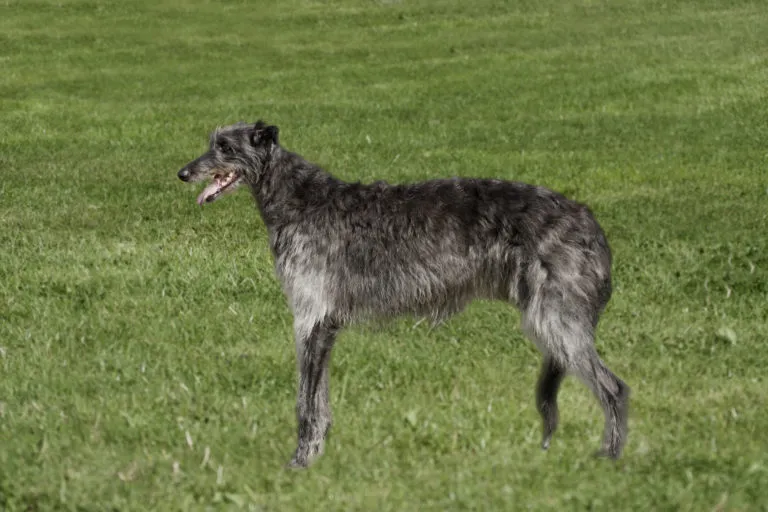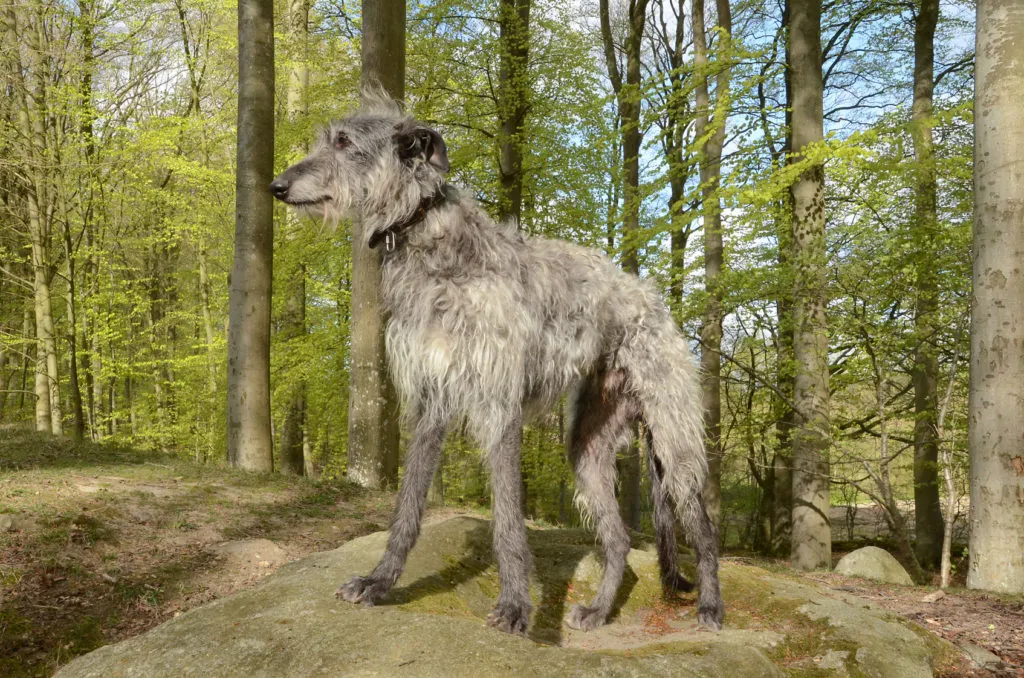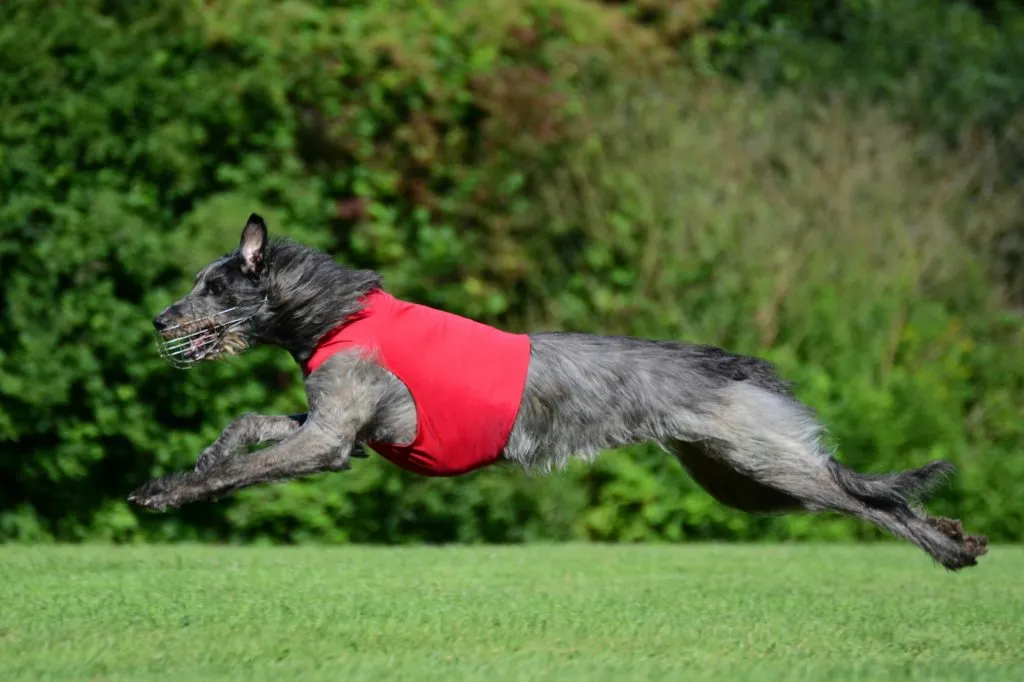Medium Size Poodle
The Deerhound, also known as the Scottish Deerhound, was used for deer hunting as early as the Middle Ages. Despite having lost its original working role, this breed still retains the same speed, agility and fearlessness. Thanks to its gentle nature, these large, rough-coated sighthounds are popular family pets today.

© Sally Wallis / stock.adobe.com
If you are looking for a large, sporty dog, the Deerhound is the ideal companion.
The Deerhound has typical sighthound traits: similar to a Greyhound, it features a characteristic, sloping, broad, and powerful croup, strong, dense bones, and well-cushioned paws. It moves with skill and suppleness, giving a powerful, harmonious impression, and reaches an impressive speed when sprinting freely. Its impeccable eyesight, strong jaw and keen hearing – traits maintained into old age – reflect its past as a hunting dog.
Furthermore, the size of the Deerhound is striking. The min. height for males is 76cm, while females, which are typically smaller, reach 71cm. Many representatives of this breed grow even taller, as there is no upper limit set by the breed standard. Equally notable is their light weight, which ranges from just 36.5kg to 45.5kg despite their considerable body size. They never appear heavy, and while other dogs may become slower and heavier with age, Deerhounds generally remain graceful and agile even as senior dogs.
Despite its elegant, almost aristocratic appearance, the Deerhound looks robust and primitive, mainly due to its shaggy, rough hair that, while not overly thick, still lies tightly and reliably repels water. The fur colour is very varied, ranging from dark or silver grey, dark blue-grey, brindle grey to yellow, sandy red, and red-brown.
The Deerhound has small rose ears, which fold back when at rest. The rod-like tail is very long, nearly reaching the ground.
 © Kim / stock.adobe.com
© Kim / stock.adobe.com
Despite its imposing size, rough fur and aristocratic appearance, the Scottish Deerhound is a loving, friendly family dog – easy to handle, obedient and adaptable. It enjoys being with its family, is sensitive to their moods, and has a strong “will to please”. The Deerhound aims to make everyone happy and wouldn’t harm a fly. It is a patient playmate for children and a reliable protector, standing faithfully and loyally by its “pack leader”. With strangers and other pets, it approaches with noble restraint, never aggressive or overly shy.
It seems unbelievable that this calm and cuddly companion was once a feared and relentless hunter, unafraid of taking on stags twice its size in the Middle Ages. As early as the 15th century, the Deerhound would hunt prey over Scottish Highlands for up to 60km, catch and bring it down before being relieved by the hunter. Today, it hasn’t lost any of these hunting skills: its speed, power and endurance remain impressive. Even though it now walks peacefully on a lead, as a well-behaved family pet, its eyes and ears are constantly alert. The Deerhound’s sharp senses pick up even the slightest rustle or smallest movement.
 © mfotohaus / stock.adobe.com
© mfotohaus / stock.adobe.com
If you want to keep a Deerhound as a family or companion dog, you should always remember that this sighthound breed originated from fast hunting. Its passion remains in free running, and while it may present itself as calm and relaxed at home, it can only enjoy sofa time after a good session of exercise. A Deerhound needs not just love and attention, but also physical and mental engagement.
Dogs with similar looks appear in ancient depictions dating back to before the birth of Christ and the 3rd century. Although the exact lineage of the Deerhound is still uncertain, it is believed to descend from large Celtic sighthounds. Whether the Celts used this dog type for hunting is unclear, but it is certain that Scottish nobles used the Deerhound for deer hunting in the Middle Ages. By the 15th century, Scottish clans were breeding these dogs specifically for this task, selecting for speed, power, agility, and bravery.
With the invention of precise hunting weapons, increasing industrialisation and the leasing of former hunting grounds, the famous hunting dogs gradually became jobless. The English victory over the Scots also ended the breeding in many areas. Around 1830, the Scottish sighthound breed was on the verge of extinction, but fortunately, brothers Archibald McNeill and Lord Colonsay took on the Highland dogs, rebuilding the famous Colonsay line with the best remaining specimens. The McNeill family continued to breed Deerhounds until 1914. The British Deerhound Club was founded in 1886, establishing the breed standard.
Thanks to its numerous positive traits, making it a pleasant and reliable partner even for non-hunters, the Deerhound has retained its popularity even with the disappearance of its original role. They are now primarily companion and family dogs. In some regions where hare coursing is still permitted and popular, Deerhounds are also used. Worldwide, breeders with great passion and care are dedicated to maintaining the many positive qualities of the Deerhound.
If you’re considering getting a Deerhound, you will eventually need to think about what your new family member eats – after all, dogs have different digestive systems from humans and can’t tolerate many foods we eat. They have different energy and nutrient needs and require special dog food that meets these needs. However, this nutrient requirement cannot be universally calculated for all Deerhounds – because a sighthound is not just a sighthound. Their needs vary depending on age, size, weight and activity level. A growing sighthound puppy needs special puppy food that caters to the higher energy demands of a young dog. For older dogs, energy needs are lower, but can increase significantly with high physical activity.
Vets or online calculators use a formula based on metabolic body weight to calculate the energy needs. However, the individual activities of the dog are usually not considered. After all, it’s challenging to fit these into a mathematical formula, as the dog’s activity levels fluctuate greatly. Does the dog live with children or other dogs? How much stress does it experience? Does it often attend dog shows? Does it mostly walk on a lead or run freely? How does it react to stimuli? Does it stay calm or become restless? All these factors influence the daily energy needs of the dog. While this knowledge may initially complicate the question of nutritional needs and the right food, it should help you not to be overly concerned by many formulas and rules. The calculations are only recommendations and do not accurately reflect what your dog truly needs. Trust your intuition! A dog that isn’t overweight, that is agile, alert and strong, with good muscles, a shiny coat, and bright, clear eyes, is undoubtedly eating the right food.
Only a few breed-specific diseases are known in the Deerhound. However, like many large sighthounds, gastric torsion can affect even completely healthy dogs and often leads to death. To reduce the risk, it can be helpful to divide the daily amount into two (smaller) meals. You should also allow your dog at least an hour of rest after eating – avoid activities involving significant movement or strenuous exercises, and wild play sessions after meals.
As you’ve read, feeding a Deerhound requires some knowledge and experience. Fortunately, you can relax when it comes to care. Thanks to its rough and shaggy fur, Scottish Deerhounds are low-maintenance breeds. Occasional brushing is sufficient for its robust coat.
The time saved due to the low-maintenance fur must be invested in the proper engagement of the Deerhound. Like all sighthounds, the Scottish Deerhound needs a lot of exercise. Simple walks on a lead are not enough. Ensure it has ample opportunities to run – such as running alongside a bike, in coursing, or freely in nature. In the latter case, be mindful of your dog’s hunting instincts. Deerhounds, as sighthounds, have exceptionally good vision and may suddenly chase prey you didn’t even notice. The key is how well your dog responds to your recall. Luckily, Deerhounds are very human-focused and readily follow their owners. If the dog lives closely with you, receives plenty of love and attention, has space, and exercises appropriately, keeping and training it – even for beginners – isn’t a problem.
Have you read a lot about the breed and think the Deerhound is the right dog for you? Next on your list is finding a breeder. Windhound clubs or national kennel clubs can provide a list of registered breeders, reducing the risk of falling for so-called “backyard breeders”, who often sell their dogs as apparent “bargains” online or in newspaper ads.
Responsible breeders are usually part of a parent organisation, ensuring adherence to breed standards with regular checks of breeders and their dogs. Certified pedigree papers guarantee a healthy, well-socialised puppy from a loving and careful upbringing. Genetic predispositions are minimised through strict exclusion processes in breeding. The price for a puppy that has already been dewormed and vaccinated starts around £1,200.
If you like the Deerhound, you might also be interested in:
Fans of the Bearded Collie agree that those who aren't familiar with this dog breed simply have to get acquainted with it. And those who have experienced how a Bearded Collie bolts across meadows with its flowing fur, how it rolls around full of energy and joy and how it attentively and observantly takes into account its owners wishes become simply addicted to this original dog breed and its unique charm.
The Goldendoodle isn't a breed, but a pairing between Golden Retrievers and Medium or Standard Poodles. Marketed as a low-maintenance dog for allergy sufferers, this hybrid is enjoying increasing popularity amongst dog lovers, similar to the Labradoodle.